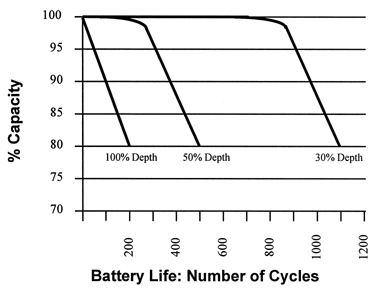|
No pierda la oportunidad de ver las ventajas del COMPROBADOR INTELIGENTE DE BATERÍAS GOLD-IBT.
1. Battery
Life Versus Temperature
|
||
|
The battery is the least reliable component of a UPS. Whereas most components give relatively little trouble over the lifetime of the UPS, the batteries need to be replaced every two to five years. The battery is also one of the most expensive components of the UPS and typically accounts for 25% or more of the initial purchase cost. Consequently, for a UPS with a service life of 10 years, and a battery life of 2 years, the total cost of battery replacement over the UPSs lifetime will be equal to, or exceed, the original purchase cost. So what factors affect battery life? Can the battery life be extended? The two main factors which determine battery life are temperature and number of discharge cycles.
|
||
|

It is very important to keep the battery as cool as possible to get full life. In an air-conditioned office, a battery inside a UPS will be a few degrees above the room ambient and temperature should not be a problem. To assure that the battery does not overheat, the UPS air inlet and outlet ports need to be free of blockages. In addition to improved battery life, good cooling should also reduce the occurrences of other problems and failures in the UPS.
|
||
| 2. Battery Life Versus The Number Of Discharge Cycles | ||
|

The number of discharge cycles is related to the quality of the mains supply. The more times the mains fail, the more times the UPS will use the battery, and the more times the battery will be discharged. Normal variations in the mains voltage throughout the day can cause some UPS types to use the battery more than others. For example, a Line-Interactive UPS will use the battery each time the tap changing transformer switches to regulate the voltage. A true On-line UPS normally will not use the battery as much as an Off-Line UPS. The wider the input voltage range, the less often the UPS will use the battery, and so on.
|
||
| 3. Ripple Current | ||
|
Another factor affecting battery is ripple current the battery sees while being charged. Depending upon the design of the charger and inverter, the battery can be subjected to miniature charge/discharge cycles with every mains cycle (50 or 60 times per second). These miniature charge/discharge cycles can result in reduced battery life by causing the battery to run hotter by a few degrees. Different UPS designs use different methods to charge the battery so each UPS will present a different level of current ripple to the battery.
|
||
| 4. Maintenance | ||
|
The majority of UPS products on the market today require, for safety reasons, turning the UPS off to maintain or replace the battery. While this is being done, the load is then susceptible to mains failures. Battery replacement will also require a skilled technician to visit the UPS site. In the case of a redundant
UPS employing modules that can be "hot-swapped." like
|
||
|
|